Member Spotlight: Korey Rowswell
March 18, 2022
The catalyst for my current body of work is volunteering at a local thrift store. Huge heaps of clothing are donated every day, but only a small amount is good enough to be put onto the store floor. The rest are shunted further down the supply chain until the items eventually end up in a landfill. I imagine our future landscape will be dominated by these landfills. The Earth’s terrain will be transformed into strata of different types of waste, with thick seams of fabric running through it. I envision new life forms evolving from these discarded garments and invading the living ecosystem. Slowly these invasive textile species will replace all living plants until our environment becomes unrecognizable.
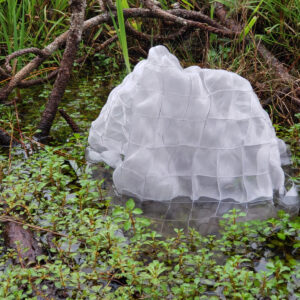
Korey Rowswell, Metaphors of Perception, 202. Pintuck organza, sewn.
Red Dirt Mourning is a visual representation of ghostly plant shoots emerging from the ground. It was inspired by my time at the Legacy Museum in Montgomery, Alabama. I think about all the lives that are lost and buried under my feet. I wanted to represent the emergence of fabric botanicals from the earth itself.
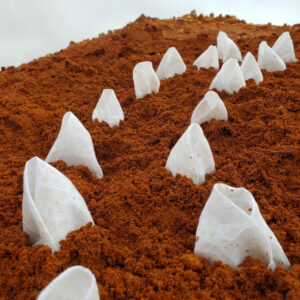
Korey Rowswell, Red Dirt Mourning, 2021. Quilters cotton installation, 3 x 3 x 3 feet.
Invasive species are highly adaptive to different environments, even useful and beautiful in some contexts. I emphasize this beauty by using fabrics in bright colors with pleasing textures and sparkly finishes. Utility is communicated through the use of wire, metal elements or industrial fabrics. Pineapple Mike was created from a deconstructed pineapple themed lunch box. I intentionally incorporated the zippers as a nod to the boxes’ utility as well as beauty. Bringing these materials together is symbolic of the gender binary in reproductive functions of a species.
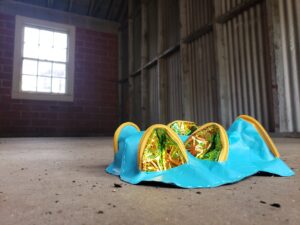
Korey Rowswell, Pineapple Mike, 2021. Pineapple themed lunch box, thread, 2.5 x 7.5 x 6.5 inches.
Photographing my invasive species in nature helped me consider how textiles communicate both place and function. There are regional differences in clothing and style choices just as there are regional difference in plant species and ecosystems. Thinking about the ways that plants use different biological formations and colors to adapt to their environment, I started applying these strategies when choosing fabrics for these sculptures. In Stereotypes Afforded Us, the bark-like texture of the dress material is both similar and distinct from the bark of the oak tree it is juxtaposed with in the photograph. The garment utilized for the sculpture informs its structural form and function within this particular habitat.
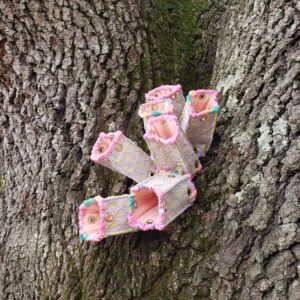
Korey Rowswell, Stereotypes Afforded Us, 2021. Mixed fabric, thread, grommets, wire installation, sewn and inserting grommets, 4 x 9.5 x 7 inches.
KoreyRowswell.com | @koreyrowswell
–Korey Rowswell creates organic fiber sculptures and installations inspired by plants and the natural environment. Korey received a BA in art history from Hastings College in 2009. In 2014, he became a fifth level instructor of the Ohara school of ikebana. He is passionate about bringing the tradition of Japanese flower arranging to American students through teaching workshops at the Kemper Contemporary Museum of Art and Powell Gardens. Korey currently resides in Montgomery, Alabama.
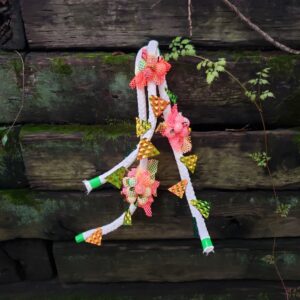
Korey Rowswell, Tragedy Magnet, 2021. Mixed fiber installation, 2 x 3 x 1.5 feet.


